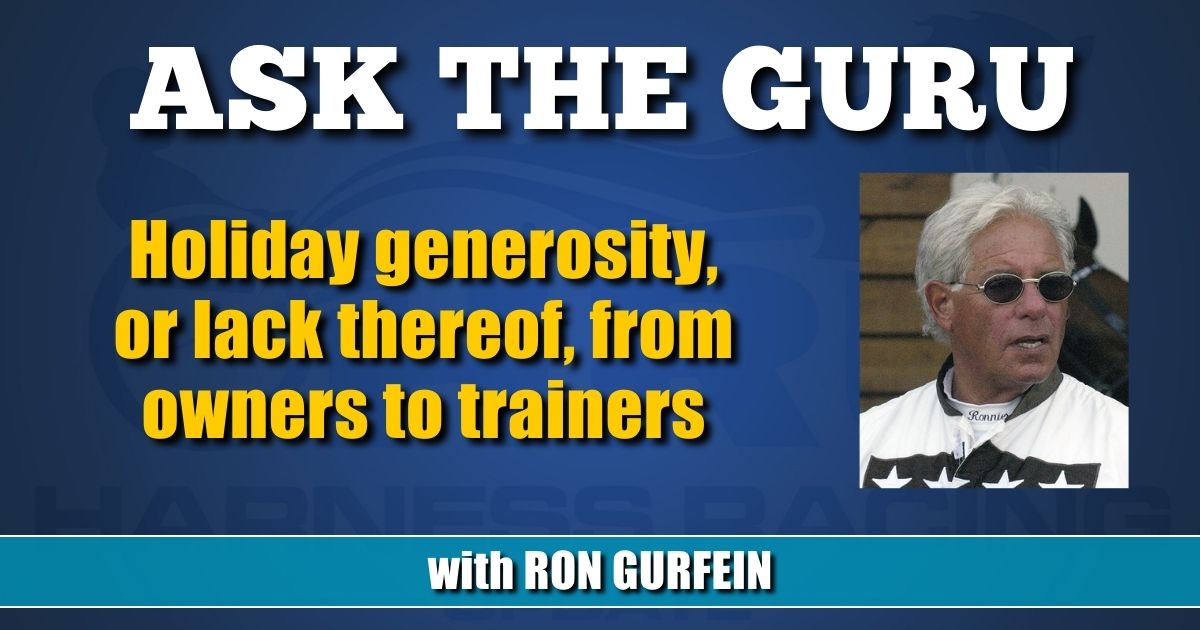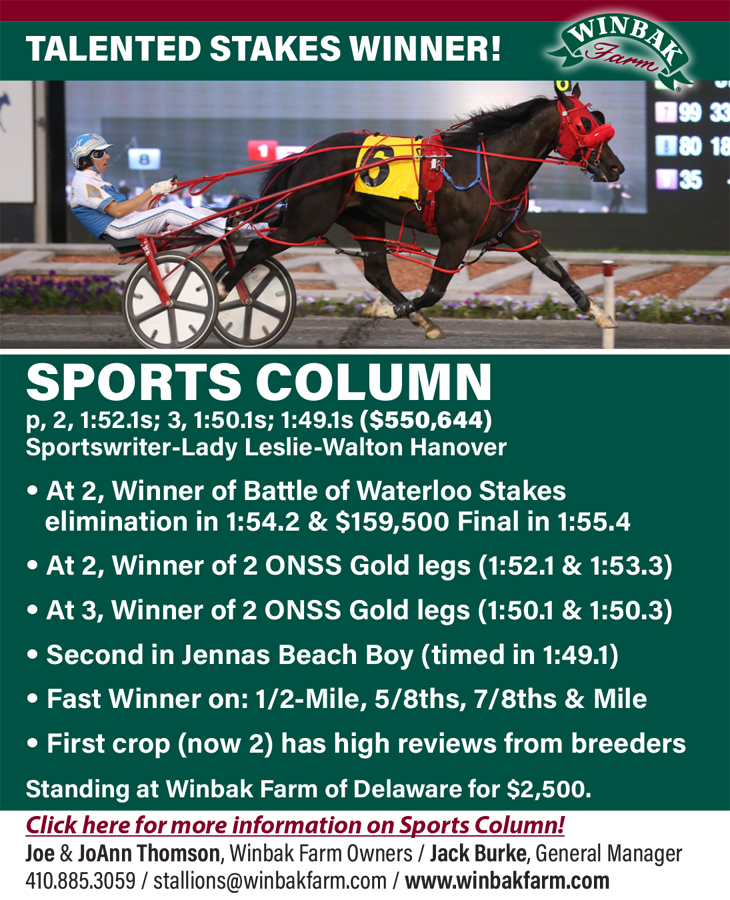Holiday generosity, or lack thereof, from owners to trainers
That and much, much more in this week’s edition of harness racing’s most popular advice column.
by Ron Gurfein
Tidbits: For all of my readers that are confused about the arguments for or against the Horseracing Integrity and Safety Act (HISA) that passed Congress and was signed into law last week let me enlighten you with some facts.
To begin with, the law doesn’t go into effect until the summer of 2022 by which time there will be much discussion on where the funding will come from. It is my understanding that as of today the plan is for the tracks and owners to foot the bill which will be approximately $30 per start. What do you get for the money? Hopefully a level playing field, and most definitely equal treatment of trainers and drivers throughout the industry. No more Indiana says no and New York says yes to an individual with questionable character. The right to race will fall to a uniform national decision and not to individual venues.
All drug rules will be on a national scale and not pertinent to individual states. There will no longer be questions on what you can race on in Pennsylvania or New York or Indiana and the withdrawal times will all be uniform.
The testing will all be at one laboratory not 50 as there are today.
I am not saying that this is a panacea, but we should put forth an effort to see if it works for us. Jim Gagliano the president and CEO of The Jockey Club is a very approachable guy and I am sure he would be more than willing to sit down with us and discuss the possibilities of a joint venture. It may even be less of a financial burden if we join.
But just to throw an opportunity like this in away because two of our leaders are opposed without a major study is ridiculous.
* * *
I want to thank Rodney Foulds for his letter about the top colt Pemberton as an example of a 2-year-old held over to 3 that had a wonderful year . Bob McIntosh said at Hambletonian time that the Paul Walker trainee was the best but not eligible. True or not true, he was pretty close to correct. The colt went 8-for-10 and won the Ontario Sires Stakes (OSS) Super Final in 1:52. Let’s hope this run continues this year in open competition.
Bill Bigler asks: It’s the holiday season. Fill us in about what your owners were like when the holidays came around or just generosity in general?
Great question because it covers the gamut of possibilities.
For my first 20 years training, there was no such thing as generosity. You had to fight for every buck. With the exception of a handful of elite horse owners that lived in the area, the only owners wanting to race in Monticello were those that wanted to chase “Bungalow Bunnies.” These were ladies whose husbands left them alone upstate during the week and visited on weekends because the commute to New York City was “too far” for them.
The rest were forced to send their stock there because it simply wasn’t good enough for the Yonkers- Roosevelt circuit.
Things were so tough in those days that I actually had an owner that said no horses train on Sunday and would deduct the daily rate multiplied by the amount of Sundays in the month from my invoice. I asked him doesn’t your horse have to eat and drink and live in a clean stall and get a little walk on Sunday? “That’s not training.” was the retort.
I did have some very nice owners in those days including Esther and Luca Balanzano, Dr. J of Hanover fame, who was about 17 years old at the time, and Sandy Goldfarb who was nothing short of a prince in those days. It was a difficult task to make a living, but it was sooooo much fun. It’s not until you are making real money that the headaches begin. I would be remiss if I didn’t mention my partner, the late Max Brewer, and Phil Tully, locals that forever were in my corner and were in support of my barn from the onset.
Once I graduated Monticello and moved my operation to the Meadowlands my owners were all people that had been in the game forever.
As far as generosity for the holidays is concerned, it really only came into play twice in my career and both times were way over the top. I will not mention the amount of the gifts, but to this writer they were shocking and amazing. The first came at a Christmas dinner at New York Prime (a top spot in Boca Raton) shortly after Baltic Striker had won the 3-year-ol Breeders Crown at Pompano Park. A wonderful man and fellow Hall Of Famer Lou Guida and his lovely wife Rose invited my wife and I to dinner. Lou, had the waiter come to the table with a huge Lobster Terrine. Beneath the lid was an envelope with a check.
The other, not nearly as dramatic, came as a Christmas card from David Scharf, another wonderful guy, after the retirement of Self Possessed. He also gave huge bonuses to my second trainer and the colt’s caretaker.
I have to say when it came to horses going to stud, my owners have gone overboard.
I think that the syndicate heads such as Frank “The Elder” Antonacci, George Segal, Alan Leavitt, and Frank Antonacci (Crown Stable) set a high bar for other owners to follow with the retirement of Victory Dream, Self Possessed, Mr Vic and Cantab Hall.
I have heard horror stories of mistreatment of trainers when it came to stallion shares. I consider myself a very lucky man to have had the pleasure of working for the above mentioned owners.
Howard Pearce asks: The eight highest priced yearlings of 2019 brought over $5 million. Collectively, they earned less than $100,000 (actually $109,000 plus) Do you think it is unusual for this to happen and do you think they will be better 3-year-olds?
To begin with, when you buy a yearling it is not one and done like college basketball. The horse hopefully has many years of racing. That said, it is unusual, but take note that there was only one pacer in the group. When you pay a high price for a trotter one tends to be on the side of caution and give time to overcome soreness and immaturity.
With the top three, I saw flashes of what could be top horses. Ineffable was amazing in her debut as I pointed out at the time. Damien make a break in the only appearance I witnessed and came back trotting and finished well. Maverick showed some talent but was the most disappointing of the three.
Damien’s brother, the fabulous Propulsion, never began to look like a horse until he was 4 and then went on to win $3 million.
It’s easy to be a Monday morning quarterback. Let’s see how the cards play out.
You asked how they were training. Answering that in January is totally out of the question because I am certain they all look fine now and you can never judge horses as these from training miles. There was no better training colt than Maverick last year. He was super impressive from day one and look how his year ended up. It’s easy to tell if a trotter will race and that he will have decent speed. How fast he eventually goes and who he beats is something no training mile in the winter will determine.
Jerry Sinclair asks: I see you rate restaurants. How do you rate the beer tent at the DuQuoin State Fair?
Fabulous. I truly miss it. It’s a one of a kind. Maybe the best pork chop in the country. People who have never been will read this article and think I have lost my mind, but you have to experience it before hanging me.
My personal experiences in DuQuoin were all wonderful from the Perfection Club with Waller and Anderson to tres Amigos and the Dead Horseman’s Party. I can’t leave out Toms and Mary’s. What a wonderful two weeks I had every year there with my dear friend Doc Narotsky.
Don Neuwirth asks: Do you have any idea why some New Zealand horses improve when they come to the U.S. more than others?
It has nothing to do with New Zealand horses, it’s true of any horses changing barns.
It’s purely a matter of who trained before and who is training now. If the Down Under trainer was just okay and the American trainer a hot shot, the result will be positive and vice-versa. If the Down Under trainer was great and the American not that good, a bad result.
Paul Zipstein asks: Years ago I read Clair Wolverton’s book in which he said harness horses were not getting faster but they had much better stamina. He cited Adios Butlers last eighth in 11.2 seconds as proof of this. Is this even remotely possible?
The Butler was a freak as were a few other old timers. But an eighth of a mile in 1:59.4 is way different than an eighth in a 1:46 mile. Not only is Mr. Wolverton wrong, but I think he is off on both counts. I think the old timers had more stamina, too. The new standardbred is a totally different animal. Much finer, lighter body and lighter boned and by far more athletic.
When you take into consideration the appearance of an Adios Butler or the body of a Tarquinius they don’t make that style anymore. Their hind ends were so big they needed special race bikes.
The standardbred of 2020 is a smaller, but much faster edition of the aforementioned animals and it is this writer’s opinion that the trend will continue until we have an animal that can race maybe 10 times a year at best.
Thanks to all my readers for the kind words. Please keep the questions coming in. Get a COVID-19 vaccine as soon as possible. Sorry about my initial From The Deck column going unpublished last Sunday. It was entirely my own fault. It will be in this Sunday. Better late than never. Have a wonderful week.
Have a question for The Guru?
Email him at GurfTrot@aol.com.

















